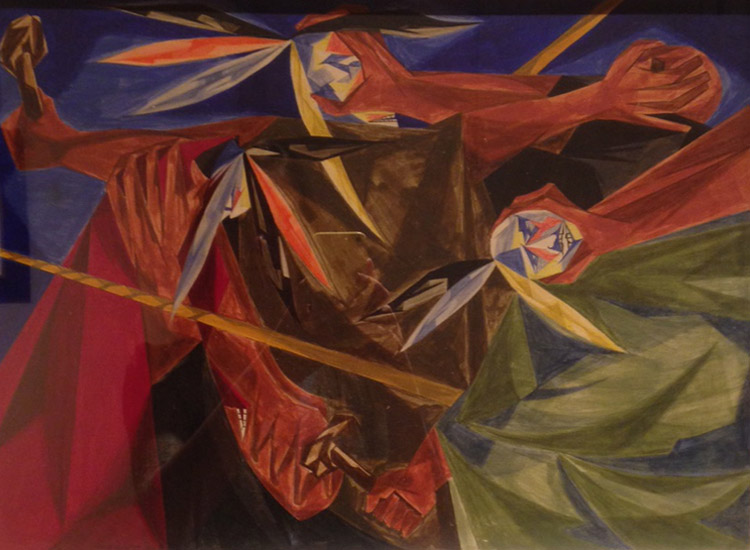This spring, former Phillips curator Beth Turner taught an undergraduate practicum at the University of Virginia focusing on Jacob Lawrence’s Struggle series. In this multi-part blog series, responses from Turner’s students in reference to individual works from the series will be posted each week.

Jacob Lawrence, Struggle … From the History of the American People, no. 13: Rally Mohawks! Bring out your axes, and tell King George we’ll pay no taxes on his foreign tea…—A Song of 1773, 1955. Egg tempera on hardboard, 16 x 12 in. Private Collection of Harvey and Harvey-Ann Ross. © 2015 The Jacob and Gwendolyn Knight Lawrence Foundation, Seattle / Artists Rights Society (ARS), New York
Rally Mohawks! Bring out your axes, and tell King George we’ll pay no taxes on his foreign tea… – A song of 1773
The Boston Tea Party is depicted in this panel with an abstracted and geometric composition. The eye follows the dynamic image and quickly absorbs a violent scene, but one lacking in anger or sentimentality. Rather, it is assertive and cogent in communicating the chaos. The colonists are shown under the guise of American Indians, which was not an arbitrary choice; for the colonists, the Indian symbolized liberty and an emerging American identity.
The issue of identity is contextually relevant to the period in which Lawrence was painting this panel. The 20th century was a time when African American identity was being formed and interrogated. Prominent African Americans, especially artists, were charged with constructing and elevating this identity and self. Jacob Lawrence agreed that this “twoness” as an American and a black man or woman existed, but that it was symbolic. Perhaps these challenging juxtapositions are also what defined the colonists and their need to appropriate the identity of the American Indian, two seemingly polar identities.
Alexis Baker
This panel depicts six figures in conflict: three masked figures, two unmasked figures, and an additional arm which leads to an “off screen” figure which is likely unmasked (the hand is grasping a masked face). Each masked figure grasps the face or head of an unmasked figure and vice versa. The masked figures wear colored garments and Indian headdresses, and the unmasked figures wear black. Two of the masked figures hold hammers in aggressive poses. Composition is triangular, every line is diagonal which lends a sense of movement and tension to the image.
As there is no evidence of a physical altercation during the Boston Tea Party, Lawrence may have intended this image to depict the ideological conflict between revolutionary Americans and loyalist Americans.
Heather Chandler
